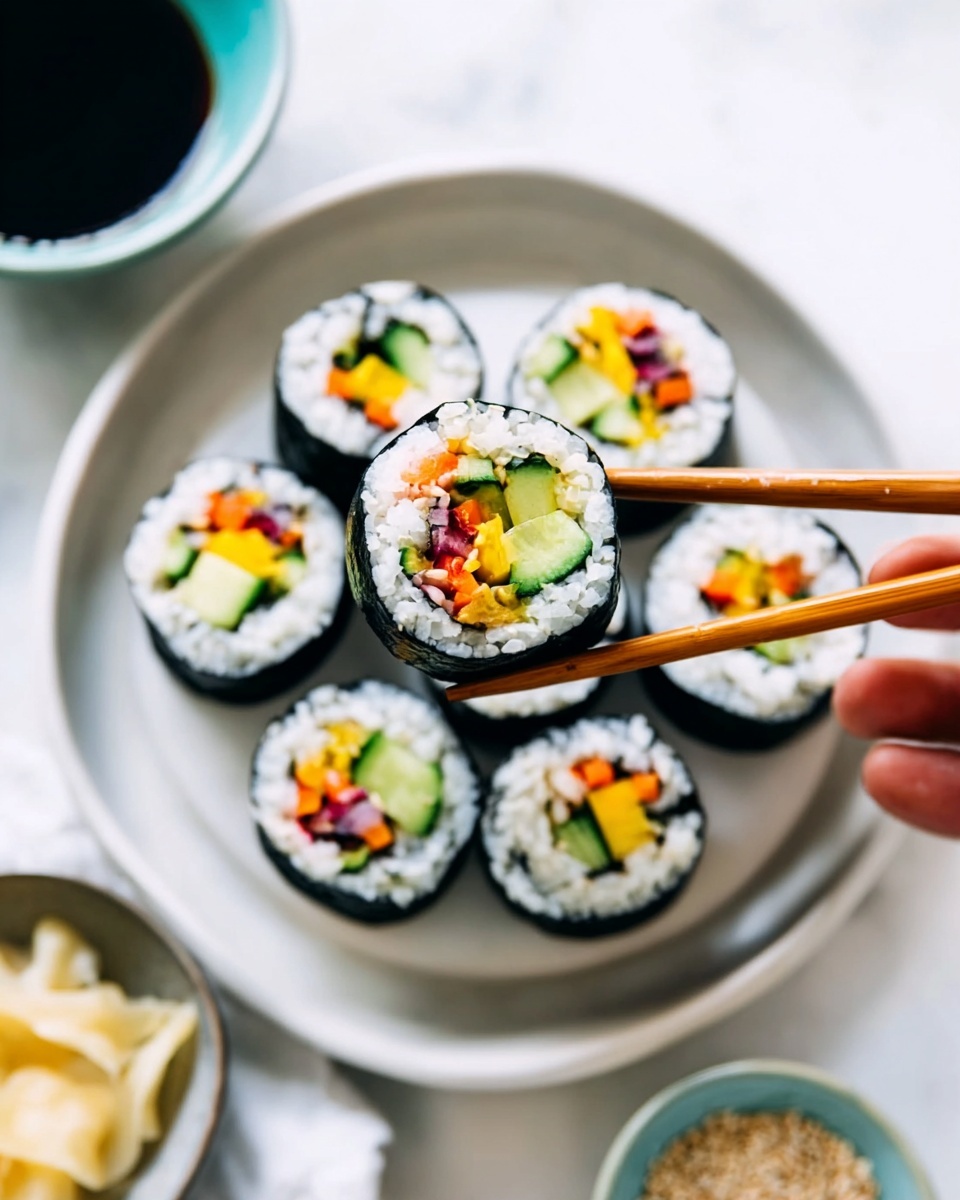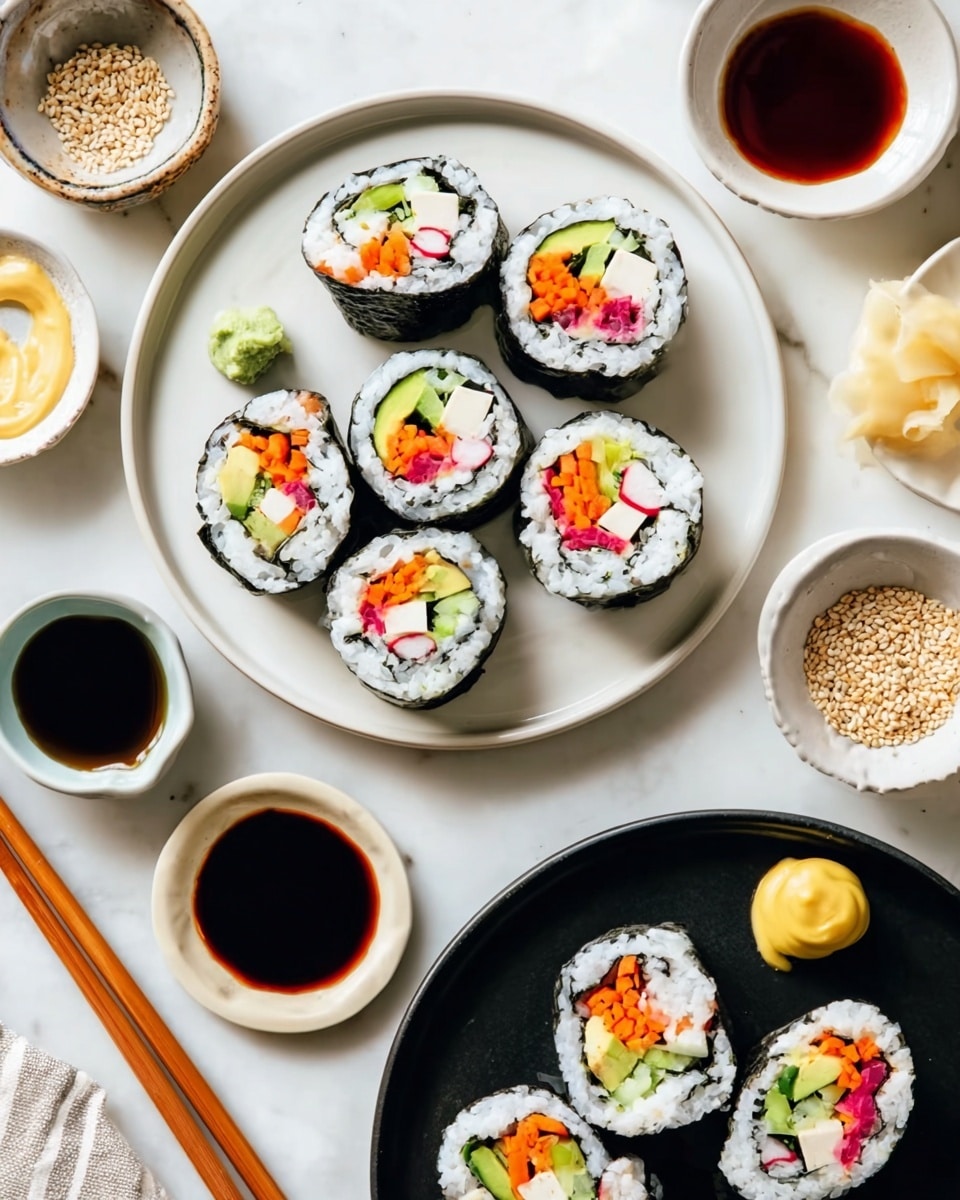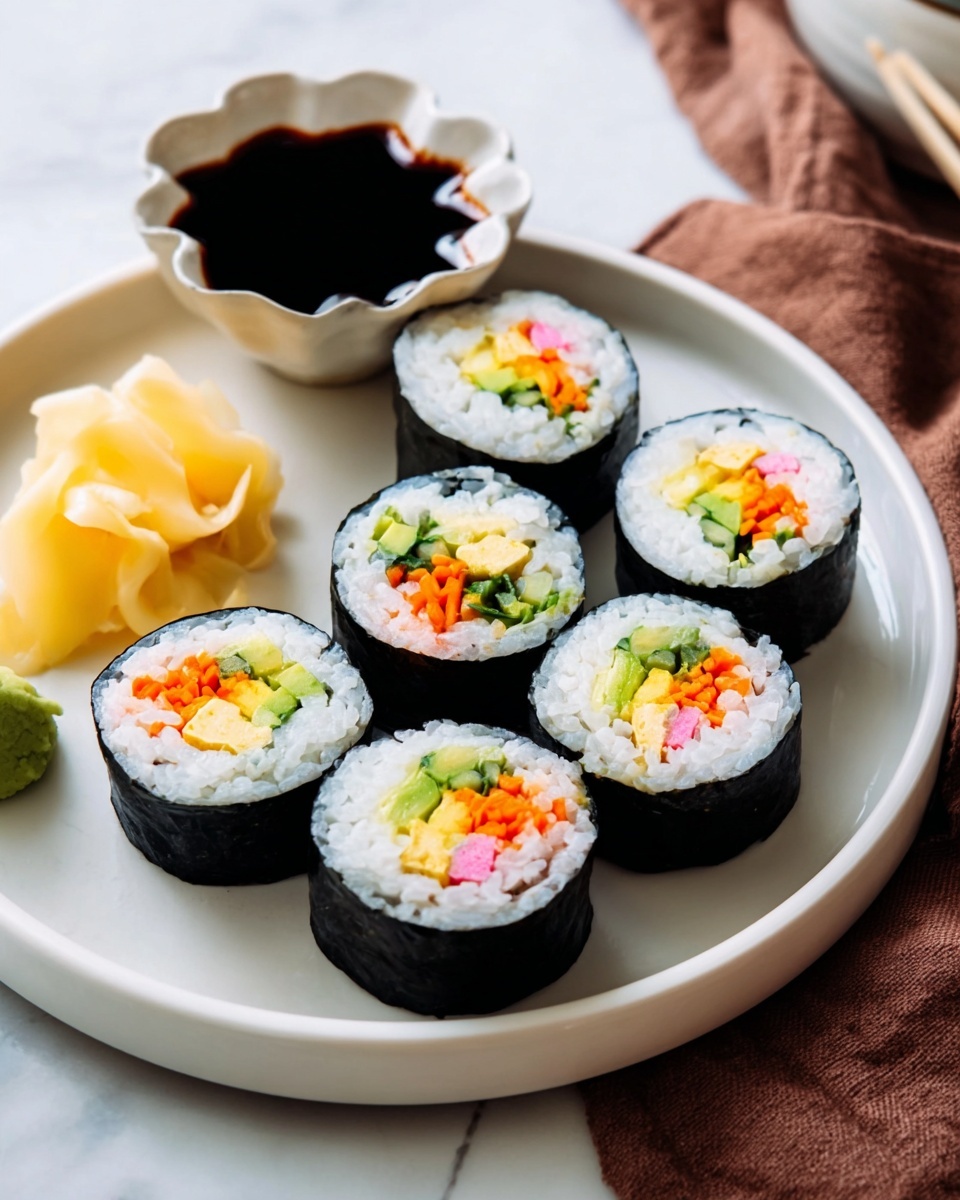If you’re craving sushi but want to keep things fresh, fun, and totally plant-based, you’re going to fall hard for my Vegetarian Sushi Rolls with Spicy Mayo Recipe. This recipe is all about combining the creamy richness of avocado, the satisfying crunch of fresh veggies, and a zesty spicy mayo that kicks up the flavor just right. Trust me, once you try these rolls, you’ll see why they’ve become a staple in my kitchen – perfect for impressing friends or just a cozy night in.
Why You’ll Love This Recipe
- Fresh, Flavorful Ingredients: Crisp cucumbers and creamy avocado balance perfectly with zesty tangy rice vinegar rice.
- Spicy Mayo Magic: The house-made spicy mayo adds a delightful kick that makes every bite exciting without overwhelming delicate flavors.
- Perfect for Any Occasion: Whether it’s a casual lunch or a chic dinner party, these vegetarian sushi rolls impress every time.
- Easy To Customize: You can swap veggies, adjust spiciness, or even make it vegan-friendly without losing the great taste.
Ingredients You’ll Need
These ingredients come together beautifully to create sushi rolls that taste restaurant-quality but without the fuss. Key tip: using proper Japanese short-grain rice really makes a difference in texture, and the pickled red onions add a surprising pop.
- Japanese short-grain white rice: Crucial for that sticky yet tender sushi texture that doesn’t fall apart.
- Kombu (dried kelp): Optional, but it infuses a subtle ocean aroma that takes the rice to the next level.
- Seasoned rice vinegar: For that classic sushi rice tang; if you can’t find seasoned, a quick homemade mix works wonders.
- Red onion: Thinly sliced and pickled, it offers a punchy bite that contrasts nicely with creamy avocado.
- Kewpie mayonnaise: The Japanese mayo is creamier and less tangy than regular mayo, key for the spicy mayo’s texture.
- Sriracha sauce: Adds heat to the mayo; adjust to your spice preference.
- Lime juice: Brightens up the spicy mayo and helps keep avocado fresh.
- Cucumbers (Japanese or Persian): Small seeded cucumbers mean less moisture and crunchier rolls.
- Carrot: Julienned for color and a slight sweetness that balances the spicy mayo.
- Deep-fried firm tofu cutlet (atsuage): Adds substance and a lovely chewy texture.
- Avocados: Choose ripe but firm for easy slicing and that buttery mouthfeel.
- Nori sheets: The essential seaweed wrapping that holds everything together.
Variations
I love that this recipe is a fantastic blank canvas. Whether you fancy adding a different veggie or want to make it vegan, you can easily tweak it to match your tastes or what’s in the fridge.
- Protein Swap: I sometimes swap the fried tofu for tempeh or marinated mushrooms for variety and a different taste experience.
- Vegan Version: Simply use vegan mayonnaise instead of Kewpie mayo, and you’re all set—still creamy and delicious.
- Seasonal Veggies: Try adding thin slices of bell peppers, asparagus, or even pickled daikon for a seasonal twist.
- Heat Level: Not into much spice? Reduce the sriracha or substitute with a mild chili sauce to keep the flavor balanced.
How to Make Vegetarian Sushi Rolls with Spicy Mayo Recipe
Step 1: Perfecting the Sushi Rice
First, rinse your Japanese short-grain rice until the water runs almost clear—this part is key for eliminating excess starch and preventing mushy rice. If you’ve never made sushi rice before, I can’t stress enough how important rinsing and soaking the rice is; it really sets the foundation. Add kombu if you have it—a little flavor booster—and cook with just the right amount of water for firm, slightly sticky rice. Then, while the rice is still hot, fold in your seasoned rice vinegar using gentle slicing motions with a paddle—no stirring or smashing here!—and fan the rice as you mix to cool it quickly and give it that perfect shiny finish. Cover it with a damp towel until you’re ready to roll.
Step 2: Prepare Your Fillings
While your rice cools, slice and prep everything else. I remove cucumber seeds because they add unwanted moisture and can make the rolls soggy—you’ll thank yourself later! The carrot gets julienned thinly for that sweet crunch. The fried tofu cutlet is cut into long strips so each bite has the right balance of chew and flavor. Avocado is sliced carefully and brushed gently with lime juice to keep it from browning. And don’t forget the pickled red onion – it brings such a fun tangy contrast that really wakes up the flavor profile.
Step 3: Make the Spicy Mayo
This spicy mayo is ridiculously simple but elevates your sushi like nothing else. Just mix Kewpie mayo (or vegan mayo) with sriracha and a splash of lime juice. I like to taste and adjust the spice level here—sometimes I add a touch more sriracha for a little extra zing. Set it aside and prepare for the rolling magic!
Step 4: Rolling Your Sushi
Here’s where the fun happens. Lay your nori sheet shiny side down on your bamboo rolling mat. Spread about a cup of sushi rice evenly, being sure to leave the top edge free to seal the roll. Use water on your fingers to keep the rice from sticking—trust me, it makes the process so much smoother! Spread a thin line of spicy mayo near the bottom edge, then layer your cucumber strips, avocado slices with pickled onion, tofu strips, and carrot. Be cautious not to overfill! Gently but firmly roll using the mat, tightening as you go so everything binds together nicely. Cover your roll with plastic wrap if you’re making more rolls to keep moisture in.
Step 5: Slice and Serve
Use a sharp knife for slicing. I recommend wiping the blade with a wet towel after each cut to keep the edges clean and prevent rice from sticking. Cut the roll in half, then into halves again, and finally into four equal pieces—you should end up with eight gorgeous sushi pieces per roll. Arrange them neatly on a plate and serve alongside soy sauce, wasabi, and pickled ginger for the full experience.
Pro Tips for Making Vegetarian Sushi Rolls with Spicy Mayo Recipe
- Keep Rice Moisturized: Cover your sushi rice with a damp towel to keep it soft—no one likes dry sushi rice!
- Rice-to-Water Ratio: I learned that cooking sushi rice a bit firmer (1:1 ratio) prevents it from turning mushy once you add the vinegar—total game changer.
- Fanning Counts: Fanning the rice while mixing cools it quickly and gives that irresistible glossy shine, making your rolls look professional.
- Sharp Knife is a Must: Use a very sharp knife and keep it wet when cutting to prevent squished sushi pieces and messy edges.
How to Serve Vegetarian Sushi Rolls with Spicy Mayo Recipe

Garnishes
I always sprinkle black sesame seeds over the rolls—they add a subtle nuttiness and look fantastic. On special occasions, I add thinly sliced green onions or even microgreens for a fresh pop of color and flavor.
Side Dishes
To make a full meal, I like to serve these sushi rolls with a light miso soup and a side of edamame tossed with sea salt. A crisp seaweed salad or pickled ginger also pairs beautifully and cleanses the palate between bites.
Creative Ways to Present
For parties, I arrange the rolls on large platters in colorful patterns or use small bowls of different sauces for dipping. Sometimes, I slice the sushi rolls and skewer each piece with a decorative toothpick for easy grab-and-go bites, which guests always love!
Make Ahead and Storage
Storing Leftovers
If you happen to have leftovers (hooray!), I recommend keeping them covered with a slightly damp kitchen towel at room temperature for up to 8 hours—this helps keep the rice moist without chilling it. Avoid refrigerating directly or the rice hardens quickly, which isn’t pleasant for sushi texture.
Freezing
Freezing sushi rolls isn’t ideal since the rice changes texture and becomes crumbly when thawed. From my experience, it’s better to freeze leftover sushi rice separately in airtight containers for up to a month, then thaw and reheat gently for future meals.
Reheating
When reheating leftover sushi rice (if stored properly), use a microwave with a little sprinkle of water and cover loosely to steam it back to softness. Avoid reheating whole sushi rolls as the delicate nori and fillings lose their texture and freshness.
FAQs
-
Can I use regular rice instead of Japanese short-grain for this Vegetarian Sushi Rolls with Spicy Mayo Recipe?
While you technically can, I don’t recommend it because other types of rice lack the right stickiness and texture to hold sushi rolls together properly. Japanese short-grain rice absorbs the sushi vinegar well and provides that signature chewiness, making your rolls easier to shape and eat.
-
How spicy is the spicy mayo, and can I adjust it?
The spicy mayo has a gentle heat from sriracha, but you can easily dial it up or down by adding more or less sauce. If you prefer mild flavors, just use a smaller amount or substitute with a mild chili sauce or even paprika for some color.
-
How do I prevent the sushi rice from becoming mushy when making this recipe?
Rinsing the rice thoroughly, cooking it slightly firm, and using a proper rice-to-water ratio are essential. Also, gently folding in the sushi vinegar with slicing motions instead of stirring, and fanning the rice as you mix to cool it quickly help maintain fluffy but cohesive rice texture.
-
Can I prepare Vegetarian Sushi Rolls with Spicy Mayo Recipe ahead of time?
You can prepare and roll the sushi a few hours before serving and keep them covered tightly at room temperature. Avoid refrigerating since it can harden the rice. Just slice and serve close to mealtime for the best texture and flavor.
Final Thoughts
This Vegetarian Sushi Rolls with Spicy Mayo Recipe is truly close to my heart because it takes traditional sushi and makes it approachable and vegetarian-friendly without skimping on flavor or fun. Every time I make these rolls, they remind me how simple, fresh ingredients with a little love can create something special. Go ahead and try this recipe—you’ll not only impress your taste buds but maybe even your sushi-loving friends. Happy rolling!
Print
Vegetarian Sushi Rolls with Spicy Mayo Recipe
- Prep Time: 45 minutes
- Cook Time: 1 hour
- Total Time: 1 hour 45 minutes
- Yield: 6 sushi rolls 1x
- Category: Main Course
- Method: Stovetop
- Cuisine: Japanese
- Diet: Vegetarian
Description
Learn how to make delicious Vegetarian Sushi Rolls with perfectly seasoned sushi rice, fresh veggies, marinated tofu, and a spicy mayo sauce. This recipe provides detailed steps for preparing sushi rice, pickled red onion, and assembling balanced rolls, ideal for a healthy and colorful meal.
Ingredients
For the Sushi Rice
- 2¼ cups uncooked Japanese short-grain white rice (3 rice cooker cups; 540 ml; yields 6⅔ cups (990 g) cooked rice)
- 2¼ cups water (540 ml)
- 1 piece kombu (dried kelp) (5 g; 2 inches x 2 inches, optional)
- ⅓ cup seasoned rice vinegar (sushi vinegar)
For the Pickled Red Onion
- ½ red onion
- ½ cup seasoned rice vinegar (sushi vinegar)
For the Spicy Mayo
- ¼ cup Japanese Kewpie mayonnaise (or vegan mayonnaise for vegan option)
- 1 Tbsp sriracha sauce
- Splash of lime juice
For the Sushi Rolls
- 2 Japanese or Persian cucumbers
- 1 carrot
- 1 deep-fried firm tofu cutlet (atsuage)
- 2 avocados
- Splash of lime juice
- 6 sheets nori (dried laver seaweed)
Instructions
- Prepare the Sushi Rice: Rinse the uncooked Japanese short-grain rice under cold water until the water runs almost clear to remove excess starch. Drain well. Place the rice in a rice cooker pot, add 2¼ cups water, and one piece of kombu on top (optional). Soak the rice for 20-30 minutes, then cook using the sushi rice mode if available or standard cooking. If no rice cooker is available, cook on stovetop or Instant Pot with the exact water ratio. After cooking, discard the kombu.
- Season the Rice: Transfer the hot cooked rice to a wooden sushi oke or a lined baking sheet to cool. Pour ⅓ cup seasoned rice vinegar over the rice. Using a rice paddle, gently slice and fold the rice at a 45-degree angle to evenly distribute vinegar without mashing the grains. Simultaneously fan the rice to cool and remove moisture, making it shiny and fluffy. Cover with a damp towel and keep at room temperature.
- Make Pickled Red Onion: Thinly slice half a red onion and place it in a glass jar or bowl. Cover with ½ cup seasoned rice vinegar and set aside to pickle while preparing other ingredients.
- Prepare Spicy Mayo: Mix ¼ cup Kewpie mayonnaise, 1 tablespoon sriracha, and a splash of lime juice together in a small bowl. Set aside.
- Prepare Filling Ingredients: Halve and seed 2 cucumbers lengthwise, then slice into 4 long strips each. Julienne 1 carrot using a peeler or cut into thin strips. Cut one fried firm tofu cutlet into slabs, then into sticks. Carefully cut 2 avocados in half, remove pits by twisting the knife embedded into pit, quarter them, peel the skin, then cut lengthwise into thin slices. Sprinkle lime juice over avocado slices to prevent browning.
- Assemble the Sushi Rolls: Place one nori sheet shiny side down vertically on a bamboo rolling mat. Evenly spread 1 cup (150 g) of sushi rice over the nori, leaving a ½ inch strip at the top edge free of rice. Spread a thin strip of spicy mayo 1½ inches from the bottom edge across the width. Layer 2-3 cucumber strips, 3 avocado slices, 2-3 tofu sticks evenly over the mayo. Add a few pickled red onion slices on the avocado and place julienned carrot strips next to them. Avoid overfilling.
- Roll the Sushi: Using thumbs and forefingers, lift the bottom edge of the mat and roll the nori forward tightly over the filling. Press gently to keep ingredients compact. Continue rolling until the seam of nori reaches the rice on the opposite side. Pull the sides of the mat to tighten the roll, then finish rolling. Cover the roll with plastic wrap to prevent drying.
- Cut and Serve: Using a very sharp, wet knife, cut the sushi roll in half, then halves into quarters, and finally each quarter in half to get 8 pieces per roll. Wipe the knife with a damp cloth between cuts to keep slices neat. Arrange on a plate and serve with soy sauce, wasabi, and pickled ginger.
- Storage Tips: Keep leftover sushi rolls covered and stored in a cool place for up to 8 hours. For overnight storage, cover rolls with a thick kitchen towel and avoid refrigeration to prevent the rice from hardening. Leftover sushi rice can be frozen up to one month in an airtight container, defrosted overnight in the fridge, and microwaved to room temperature before use.
Notes
- Use Japanese short-grain rice specifically designed for sushi for proper texture and stickiness.
- Discard the kombu after cooking or repurpose it for simmered dishes.
- Moisturize hands or utensils with water to prevent rice sticking while spreading.
- Seed removal from cucumbers eliminates excess moisture inside the rolls.
- Pickled red onion vinegar helps prevent avocado discoloration inside the rolls.
- Do not refrigerate sushi rolls or rice directly as it causes dryness and hardening.
- Fanning sushi rice during seasoning is crucial to achieve shiny, non-mushy texture.
- Slicing the sushi roll with a wet knife ensures clean and precise cuts.
Nutrition
- Serving Size: 1 sushi roll (approx. 8 pieces)
- Calories: 280
- Sugar: 3g
- Sodium: 380mg
- Fat: 12g
- Saturated Fat: 2g
- Unsaturated Fat: 9g
- Trans Fat: 0g
- Carbohydrates: 36g
- Fiber: 5g
- Protein: 7g
- Cholesterol: 5mg




Your email address will not be published. Required fields are marked *